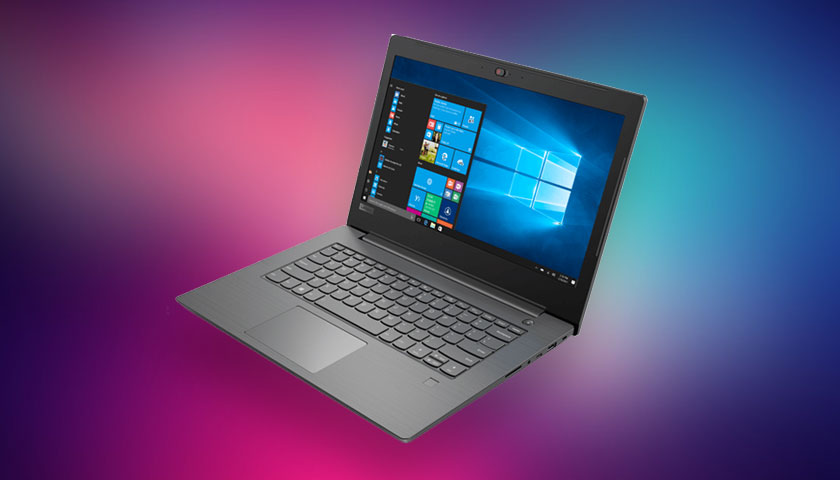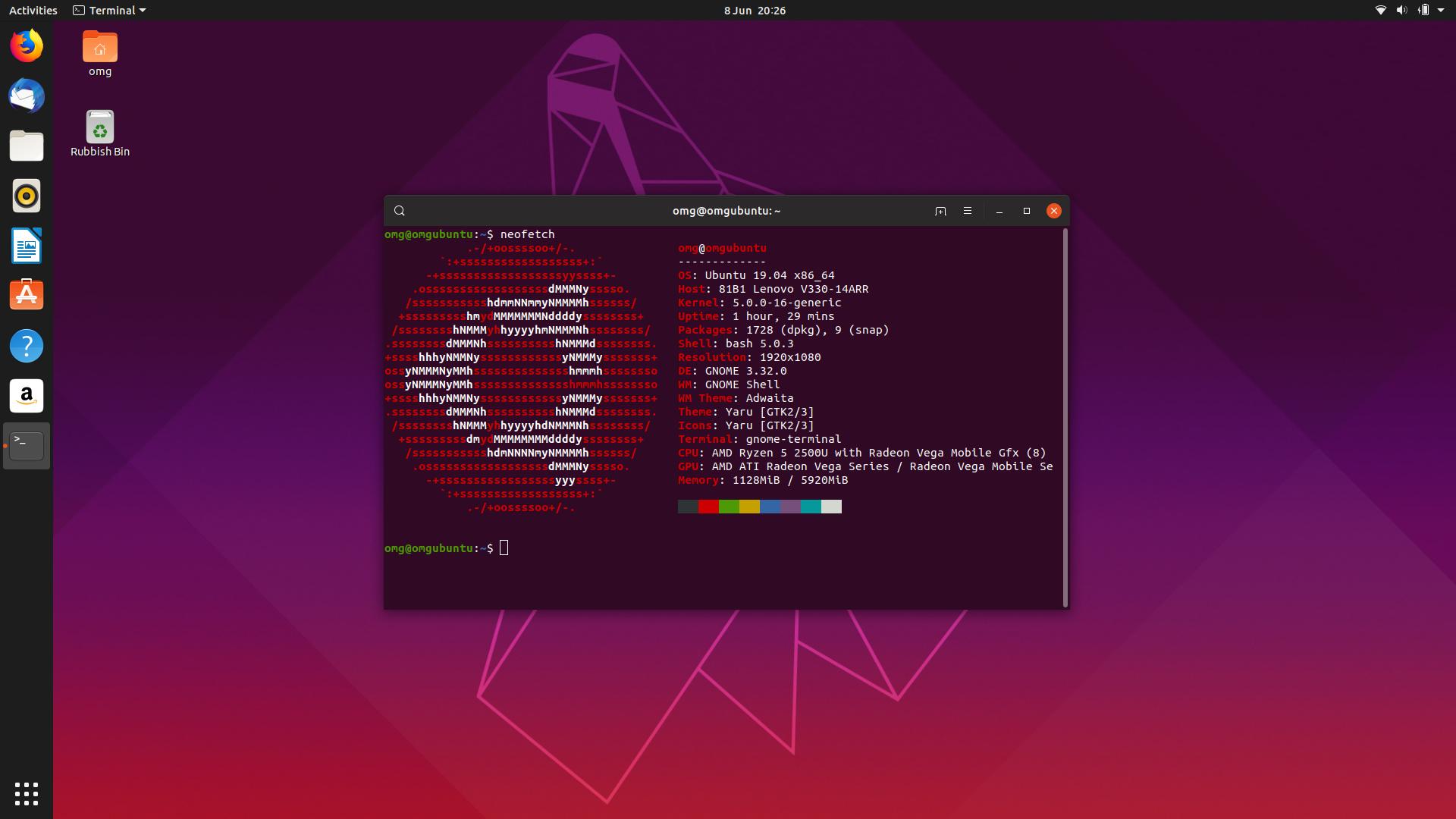I’ve been in desperate need of a dedicated Linux laptop for a while so I’m pleased to say that — hurrah — I have one!

Lenovo V330-14ARR
| Display | 14-inch TN (1920×1080) |
|---|---|
| CPU | AMD Ryzen 5 2500U @ 2GHz (3.6Ghz Turbo; Quad-Core) |
| RAM | 8GB DDR4 |
| Storage | 256GB SSD |
| Graphics | AMD Radeon Vega 8 |
| Features | HD Webcam, Speakers, SD Card Reader |
| Ports | VGA; HDMI; USB 3.0; USB Type-C; Ethernet |
| OS | Windows 10 Home |
| Weight | 1.8 kg |
Until now I’ve been making do with a co-opted Acer Chromebook R11 as my go-to Linux portable.
While that ancient Chromebook (running Linux) is great for travelling (and has a great screen) I will say the modern Ubuntu desktop doesn’t jive well with only 2GB RAM.
Prior to the Acer I’d relied on a succession of low-power, low-end netbooks, showing you just how long I’ve been without a proper laptop!
Now, not being rich (a recurring theme in my life, sob) my budget for a new Linux laptop was £400 max. That put swanky Linux laptops I write about (e.g., Slimbook, Entroware, StationX, Dell, et al) well out of my reach.
Thankfully, all the major laptop makers offer a range of mid-level Windows 10 notebooks, so a decent selection was available to me.
Budget aside, my main requirements were that the laptop was new; had a 12-14-inch screen; at least 8GB RAM; and a processor which, ideally, wasn’t an Intel Celeron.
Lenovo V330-14ARR with Linux
Sifting through a sea of similar looking portables from the usual sellers I stumbled across a so-so Lenovo V330-14ARR at a wallet friendly £359 and hit “buy”.
Now, don’t get jealous; this laptop is nothing fancy at all.
Aimed squarely at “small medium businesses” (SMB), the Lenovo V330-14ARR is a frill-free, stripped back reversion of Lenovo’s V3x series laptops. No backlit keyboard, no fingerprint reader, no IPS screen.
The latter missing feature would be something I’d come to regret since the terrible 14-inch TN panel display is dim, muddy, and has very, very poor viewing angles. It might well be 1920×1080, but there’s not point having a HD screen if it’s less vivid than a Nintendo Game Boy from the 1990s.
The Lenovo V330-A4ARR boasts terrible battery life and a terrible screen – but the specs are decent
The Lenovo V330-14AAR also boasts an awfully short internal battery (though there’s a slot for an optional second battery, but those cost 1/3 of the laptop itself).
But you know what? Those issues aside, the model offers decent enough specs in a decent enough chassis with (guess what?) a decent enough keyboard.
A few nice extras are included, such as a physical camera shutter, an above-par HD webcam, and a USB Type-C port to connect my dead Nexus 5X to.
The AMD Ryzen 5 2500U chip isn’t terrible for a laptop chip. In benchmarks it performs well against the 8th Gen Intel Core i5-8250U chip that’s inside my Acer Chromebook Spin 13 (this chip was my initial “would like to have”).
Dual-Booting Ubuntu 19.04 & Windows 10
I set up a dual-boot with Windows 10 and Ubuntu 19.04 (though via the “something else” method, not the “install Ubuntu alongside Windows 10” option).
Ubuntu 19.04 runs like a champ on this laptop – everything ‘just works’ out of the box…
I’ve no major desire to use Windows 10 but I figure it’d be nice to toy around with the new Windows Subsystem for Linux 2 sometime (and if I ever get OMG! Chrome! back up and running, it’ll help).
Ubuntu 19.04 runs like a champ on this machine, by the way. Everything “just works” out of the box, including the touchpad, wi-fi, webcam, hot keys, and all ports.
So, for now, I’ll continue to squint.
One minor drawback to running Ubuntu on this machine is the scaling.
…But I’ll keep Windows 10 around so I can play with Windows Subsystem for Linux 2
At 100%, the default setting, window borders and toolbars are a little too small. But at 200%, the only other option available by default, everything is WAY TOO BIG.
Windows 10 is set to 150% scaling by default which looks “normal” (but I find 125% looks best). I did enable fractional scaling in Ubuntu 19.04 but it seems to increase CPU load significantly.
This is in total contrast to Windows 10 which refuses to let me reverse the touchpad scrolling! Windows insists on using its own driver, regardless of how many times I install the Lenovo-provided one.
Anecdotal, but Ubuntu 19.04 with the Slimbook Battery tool also seems to give me longer battery life than Windows 10 + energy saver mode.
And the point of this post is?
All that waffle simply to say I have a new Linux laptop — breaking news, right? 😉
It’s just been such a long time since I got to use proper Ubuntu while out and about in coffee shops and the like. No caveats, no catches, no limitations (well, apart from the battery).
But this post is mostly here to say a big thank you to everyone who replied to my “how is Linux support for Ryzen machines” tweet last week:
Although mixed (older Linux kernels don’t run well) your responses helped me go from ‘mulling a purchase’ to ‘making a purchase’ in double-quick time.
And as this machine only cost £359, I’ve got £41 left over to spend on a decent bluetooth game controller…
Not only can I will I be able to use Ubuntu away from home, but I might finally be able to play SuperTuxKart properly…


